In the previous section, we learned the KNN classification algorithm.Among them: Classification means that the Y variable is categorical, such as color category, computer brand, and reputation.
The linear regression algorithm learned today, where: Regression means that the Y variable is a continuous numerical variable, such as house price, population, and rainfall.
1. Simple linear regression
1-1, Simple Linear Regression
- Many decision-making processes are usually based on relationships between two or more variables
- Regression analysis is used to establish equations that simulate how two or more variables relate to each other.
- The predicted variable is called dependent variable, y, output
- Variables used to make predictions are called independent variables, x, input
1-2. Introduction of Simple Linear Regression
-
Simple linear regression contains an independent variable (x) and a dependent variable (y)
-
The relationship between the above two variables is simulated by a straight line
-
If it contains more than two independent variables, it is called multiple regression.
1-3. Simple linear regression model
-
The equation used to describe the relationship between dependent (y) and independent (X) variables and errors is called a regression model.
-
Simple linear regression models are:

y: The predicted value of the sample, that is, the strain in the regression model
x: The characteristic value of the sample, that is, the independent variable in the regression model
Epsilon: An error term in a regression model that indicates variability contained in y but not explained by the linear relationship between x and Y
Essential: Find a straight line to best fit the relationship between sample characteristics and sample output markers
2. Derivation by Least Squares Method
ordinary
First, our goal is to find a and b so that the loss function:

As small as possible.
Here, the simple linear problem is turned into an optimization problem.The following is the derivation of each position component of the function, where the derivative is 0 is the extreme value:

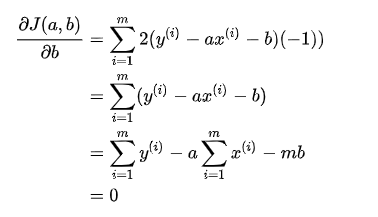
Then mb mentions before the equal sign, dividing both sides by m, and each item on the right side of the equal sign is equal to the mean.



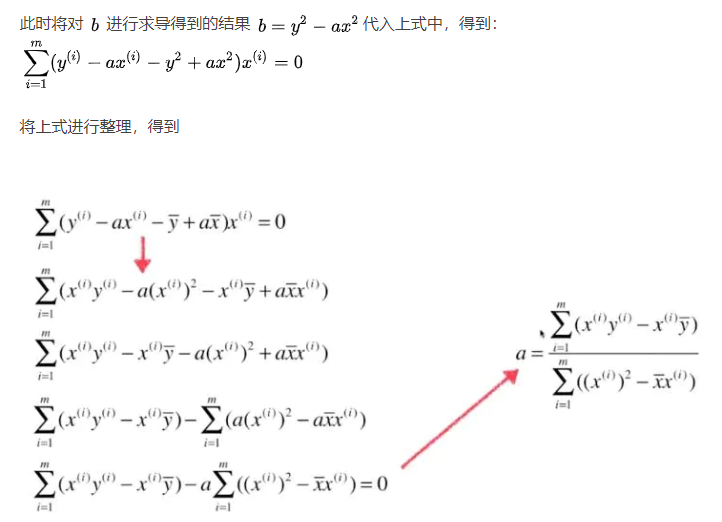
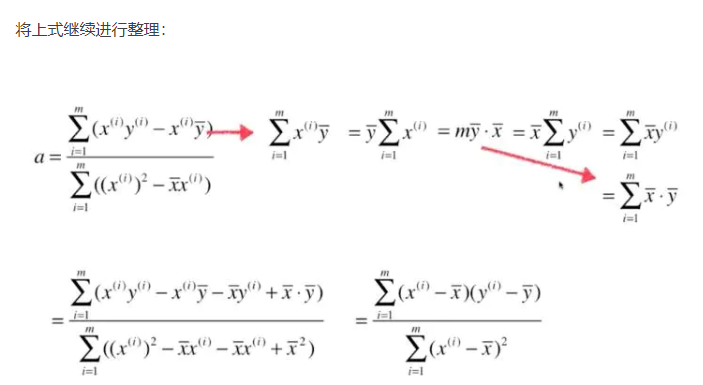
This is much simpler to implement.
Finally, we get the expression of a and b by least squares:

vector
Bridging Style

Change to Matrix Representation

Put Transpose Inside Brackets

Multiplicative Expansion

Finding gradients

Last Transpose Write On

merge
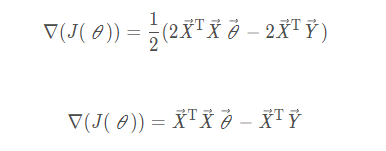
Find the stationary point of the gradient,
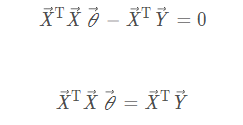
The final analytic formula for the parameter theta is obtained



Why not use least squares
In the last section, the least squares method is deduced theoretically and the result is very beautiful, but it is not often used in practice for the following reasons:

3. Implementation of Simple Linear Regression Code
Reference link: https://blog.csdn.net/zhaodedong/article/details/102855126
4. Multivariate Linear Regression
4-1. What is Multivariate Linear Regression
In regression analysis, if there are two or more independent variables, it is called multivariate regression.In fact, a phenomenon is often associated with multiple factors. Predicting or estimating a dependent variable by the optimal combination of multiple independent variables is more effective and practical than predicting or estimating it by only one independent variable.Therefore, multivariate linear regression is more practical than univariate linear regression.
4-2, Derivation
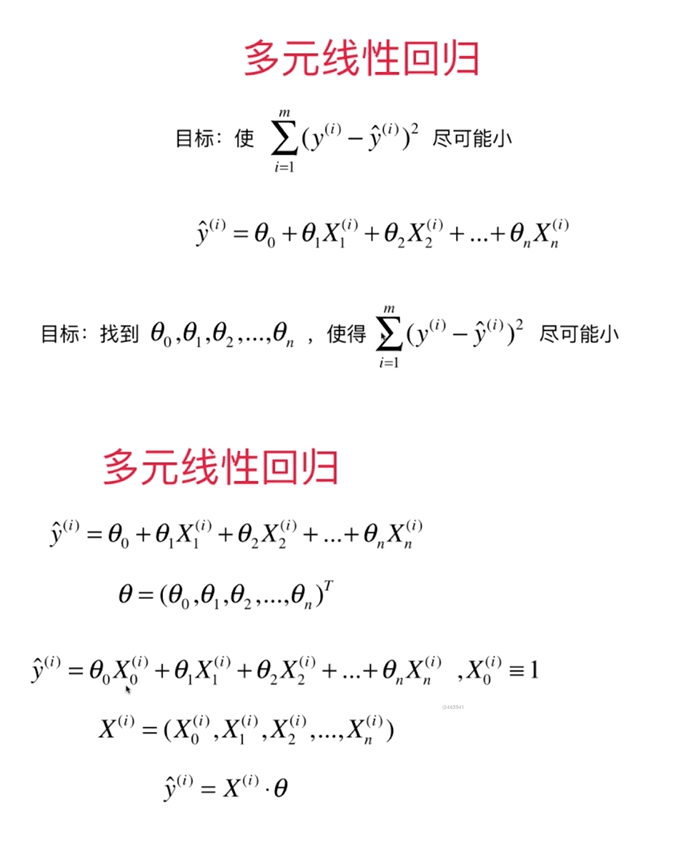
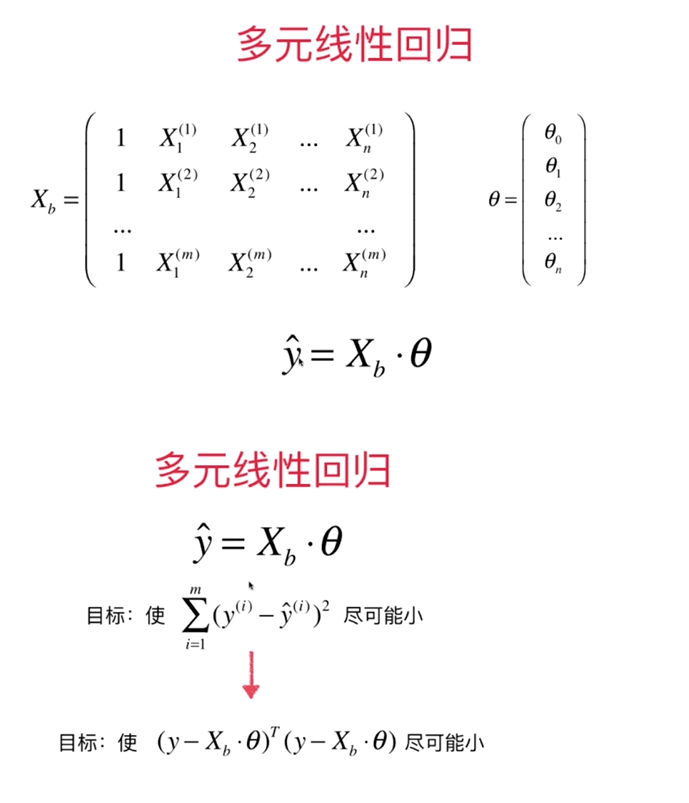
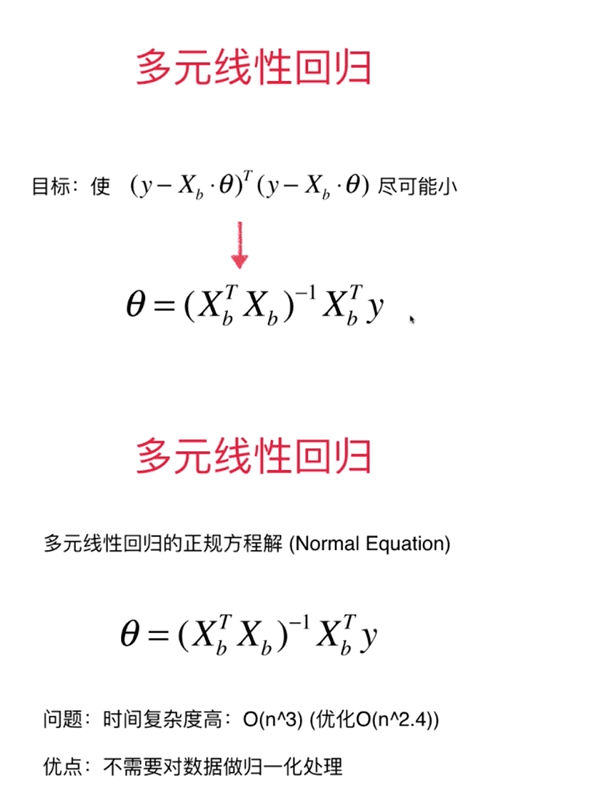
4-3, Code implementation
import numpy as np import matplotlib.pyplot as plt from sklearn import datasets #Loading datasets boston=datasets.load_boston() X = boston.data y = boston.target X = X[y < 50.0] y = y[y < 50.0] #Load your own modules from playML.LinearRegression import LinearRegression reg = LinearRegression() #Instantiation process reg.fit_normal(X_train,y_train) #The process of training datasets reg.coef_ #View corresponding feature attribute values ''' array([-1.18919477e-01, 3.63991462e-02, -3.56494193e-02, 5.66737830e-02, -1.16195486e+01, 3.42022185e+00, -2.31470282e-02, -1.19509560e+00, 2.59339091e-01, -1.40112724e-02, -8.36521175e-01, 7.92283639e-03, -3.81966137e-01]) ''' reg.intercept_ #Intercept: 34.16143549624022 reg.score(x_test,y_test) #View the accuracy of the algorithm: 0.8129802602658537
Linear Regression Using sklearn
import numpy as np import matplotlib.pyplot as plt from sklearn import datasets #Loading data boston=datasets.load_boston() X = boston.data y = boston.target #Data preprocessing, removing points on the boundary X = X[y < 50.0] y = y[y < 50.0] #The original data is divided into training data and test data by self-written segmentation method from playML.model_selection import train_test_split X_train,x_test,y_train,y_test=train_test_split(X,y,seed=666) #Import corresponding modules from sklearn.linear_model import LinearRegression lin_reg = LinearRegression() lin_reg.fit(X_train,y_train) #Value of the eigenvalue lin_reg.coef_ ''' array([-1.18919477e-01, 3.63991462e-02, -3.56494193e-02, 5.66737830e-02, -1.16195486e+01, 3.42022185e+00, -2.31470282e-02, -1.19509560e+00, 2.59339091e-01, -1.40112724e-02, -8.36521175e-01, 7.92283639e-03, -3.81966137e-01]) ''' #intercept lin_reg.intercept_ #34.16143549624665 #Test algorithm accuracy R Squared lin_reg.score(x_test,y_test) #0.8129802602658495